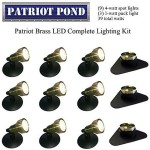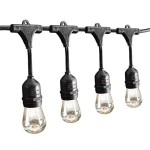Outdoor Solar Lighting Ideas: Illuminating Your Space Sustainably
Outdoor lighting elevates the functionality and aesthetic appeal of any property. However, traditional wired outdoor lighting can be expensive to install and operate, requiring trenching, wiring, and increased electricity bills. Solar-powered outdoor lighting provides a sustainable and cost-effective alternative, harnessing the sun's energy to illuminate pathways, gardens, patios, and more. This article explores a variety of outdoor solar lighting ideas, providing insights into choosing the right options for specific needs and spaces.
When considering outdoor solar lighting, it is important to understand the basic components. A solar light typically consists of a photovoltaic (PV) panel, a rechargeable battery, a light source (usually an LED), and a control circuit. The PV panel converts sunlight into electricity, which is stored in the battery. The control circuit manages the charging and discharging of the battery, turning the light on at dusk and off at dawn, or based on programmed settings.
The effectiveness of solar lighting relies heavily on the amount of sunlight it receives. Placement is critical to ensure sufficient charging. The direction and angle of the solar panel should be optimized to capture maximum sunlight. The amount of available sunlight varies depending on geographic location, season, and weather patterns. Therefore, it's prudent to consider the average daily sunlight hours when selecting and positioning solar lights.
Key Point 1: Types of Outdoor Solar Lights and Their Applications
The market offers a wide array of outdoor solar lights, each designed for specific purposes and aesthetics. Understanding the different types is essential for making informed decisions.
Solar Path Lights: These are perhaps the most common type, designed to line walkways, driveways, and garden paths. They typically feature a stake that is inserted into the ground, providing a low-level illumination for safe and convenient navigation. Path lights are available in various styles, from traditional lantern designs to modern, minimalist forms. Brightness levels also vary, so consider the width of the path and the desired level of illumination.
Solar Spotlight: Spotlights are designed to highlight specific features of a landscape, such as trees, shrubs, sculptures, or architectural details. They provide a concentrated beam of light that can be adjusted to direct attention to the desired object. Solar spotlights often have adjustable heads, allowing for precise aiming. They are useful for enhancing the aesthetic appeal of a garden or highlighting security features.
Solar Flood Lights: Offering broader illumination than spotlights, flood lights are suitable for lighting larger areas, such as patios, decks, or garages. They are often used for security purposes, providing a deterrent to potential intruders. Solar flood lights typically have a higher lumen output than other types of solar lights and may feature motion sensors for added functionality.
Solar String Lights: String lights add a decorative touch to outdoor spaces, creating a festive and inviting atmosphere. They are ideal for patios, pergolas, fences, and trees. Solar string lights are available in various bulb styles, including traditional incandescent-style bulbs, fairy lights, and globe lights. They can be easily strung up and require no wiring, making them a convenient and versatile option.
Solar Post Lights: These lights are designed to be mounted on existing posts or new installations, providing illumination for decks, fences, or gate entrances. Solar post lights are typically more robust and durable than other types of solar lights, designed to withstand the elements. They offer a permanent and aesthetically pleasing lighting solution.
Solar Wall Lights: Wall lights are mounted on exterior walls, providing ambient lighting for patios, porches, or entryways. They can be used to enhance security, improve visibility, or simply add a touch of style to the exterior of a home. Solar wall lights are available in various designs, from traditional sconces to modern, minimalist fixtures.
Solar Rock Lights: These lights are designed to resemble natural rocks or stones, blending seamlessly into the landscape. They are ideal for adding subtle illumination to gardens, pathways, or water features. Solar rock lights are typically made from durable materials that can withstand the elements, and they provide a discreet and natural-looking lighting solution.
Key Point 2: Factors Affecting the Performance of Solar Lights
Several factors influence the performance of solar lights, influencing their brightness, duration of illumination, and overall lifespan. Understanding these factors is critical for optimizing the effectiveness of solar lighting systems.
Battery Capacity: The battery's capacity determines how long the light can operate on a single charge. A higher capacity battery will provide longer hours of illumination, especially during cloudy days or periods of low sunlight. Lithium-ion batteries are commonly used in solar lights due to their high energy density and long lifespan, but other battery types may be used as well.
Panel Size and Efficiency: The size and efficiency of the solar panel directly affect the amount of energy that can be harvested from sunlight. A larger, more efficient panel will generate more electricity, resulting in faster charging and brighter illumination. Monocrystalline and polycrystalline solar panels are the two main types, with monocrystalline panels generally being more efficient.
LED Brightness and Efficiency: The brightness of the LED light source is measured in lumens. A higher lumen output indicates a brighter light. However, it's important to consider the efficiency of the LED, as more efficient LEDs will produce more light while consuming less energy, extending the battery life. LED color temperature, measured in Kelvin, also influences the perceived brightness and ambiance. Warmer color temperatures (lower Kelvin values) create a softer, more inviting light, while cooler color temperatures (higher Kelvin values) produce a brighter, more focused light.
Weather Conditions: Cloudy days and periods of low sunlight can significantly reduce the charging capacity of solar lights. In regions with frequent overcast skies, it's advisable to choose solar lights with larger solar panels and higher capacity batteries to compensate for the reduced sunlight exposure. Snow cover can also impede sunlight from reaching the solar panel, requiring occasional cleaning.
Panel Placement and Obstructions: The placement of the solar panel is crucial for optimal charging. Avoid placing solar lights in areas that are shaded by trees, buildings, or other obstructions. The panel should be positioned to receive direct sunlight for as many hours as possible each day. Regularly cleaning the solar panel can also improve its efficiency by removing dust, dirt, and debris that can block sunlight.
Operating Temperature: Extreme temperatures can negatively affect the performance of solar lights. High temperatures can reduce battery capacity and lifespan, while low temperatures can slow down charging. Choose solar lights that are designed to withstand the climate conditions in your area.
Key Point 3: Installation and Maintenance of Outdoor Solar Lights
Proper installation and regular maintenance are essential for maximizing the lifespan and performance of outdoor solar lights. Following these guidelines will ensure that your solar lights continue to provide reliable illumination for years to come.
Placement and Positioning: As previously mentioned, the placement of the solar panel is critical. Choose a location that receives ample sunlight throughout the day. If possible, orient the panel towards the south in the northern hemisphere and towards the north in the southern hemisphere. Adjust the angle of the panel to maximize sunlight exposure based on the latitude of your location.
Initial Charging: Before using a new solar light, it's recommended to fully charge the battery in direct sunlight for several hours, typically 6-8 hours or as specified by the manufacturer's instructions. This initial charging ensures that the battery is fully conditioned and will perform optimally.
Cleaning and Maintenance: Regularly clean the solar panel with a soft cloth to remove dust, dirt, and debris. Avoid using harsh chemicals or abrasive cleaners, as these can damage the panel. Periodically inspect the light for any signs of damage, such as cracks or loose connections. Replace any damaged components promptly to prevent further problems.
Battery Replacement: Over time, the battery in a solar light will degrade and need to be replaced. The lifespan of the battery varies depending on the quality of the battery and the usage conditions. When replacing the battery, use a compatible replacement battery that meets the original specifications. Dispose of the old battery properly, following local regulations for electronic waste disposal.
Winter Storage: In regions with harsh winters, it's advisable to store solar lights indoors during the off-season. This will protect the battery from extreme temperatures and prolong its lifespan. Before storing the lights, fully charge the battery and clean the solar panel. Store the lights in a cool, dry place.
Troubleshooting: If a solar light stops working, check the following: Ensure that the solar panel is clean and free of obstructions. Verify that the battery is fully charged. Check the switch to make sure it is in the "on" position. If the light still doesn't work, the battery may need to be replaced, or there may be a problem with the internal circuitry. Consult the manufacturer's instructions or contact a qualified technician for assistance.
By considering these ideas, factors, and guidelines, homeowners can effectively utilize outdoor solar lighting to enhance the beauty, safety, and sustainability of their properties. With careful planning, selection, and maintenance, solar lighting can provide years of reliable and cost-effective illumination.

Solar Garden Lighting Ideas 18 Pretty Energy Saving

Cool Sustainable And Stylish Diy Ideas For Outdoor Solar Lighting Urban Gardens

10 Best Outdoor Lighting Ideas Landscape Design Secrets A Piece Of Rainbow

30 Cool Backyard Lighting Ideas For Magical Decors

10 Best Outdoor Lighting Ideas Landscape Design Secrets A Piece Of Rainbow

10 Best Outdoor Lighting Ideas Landscape Design Secrets A Piece Of Rainbow

Decorative Solar Light Ideas Hoselink Blog

30 Cool Backyard Lighting Ideas For Magical Decors

10 Ways To Illuminate Your Outdoor Areas With Residential Solar Lights Gamasonic Usa

15 Amazing And Easy Solar Light Ideas To Diy
Related Posts







